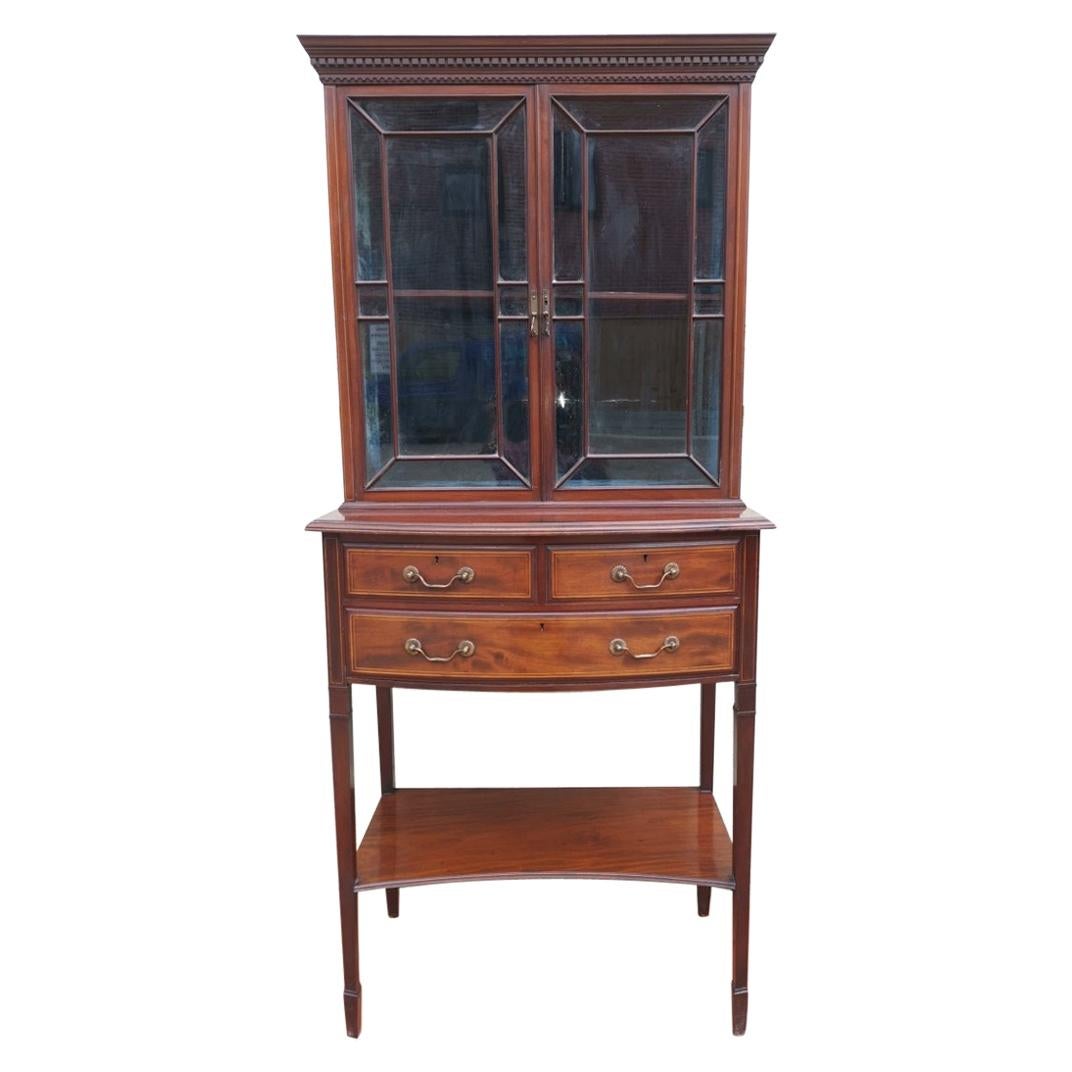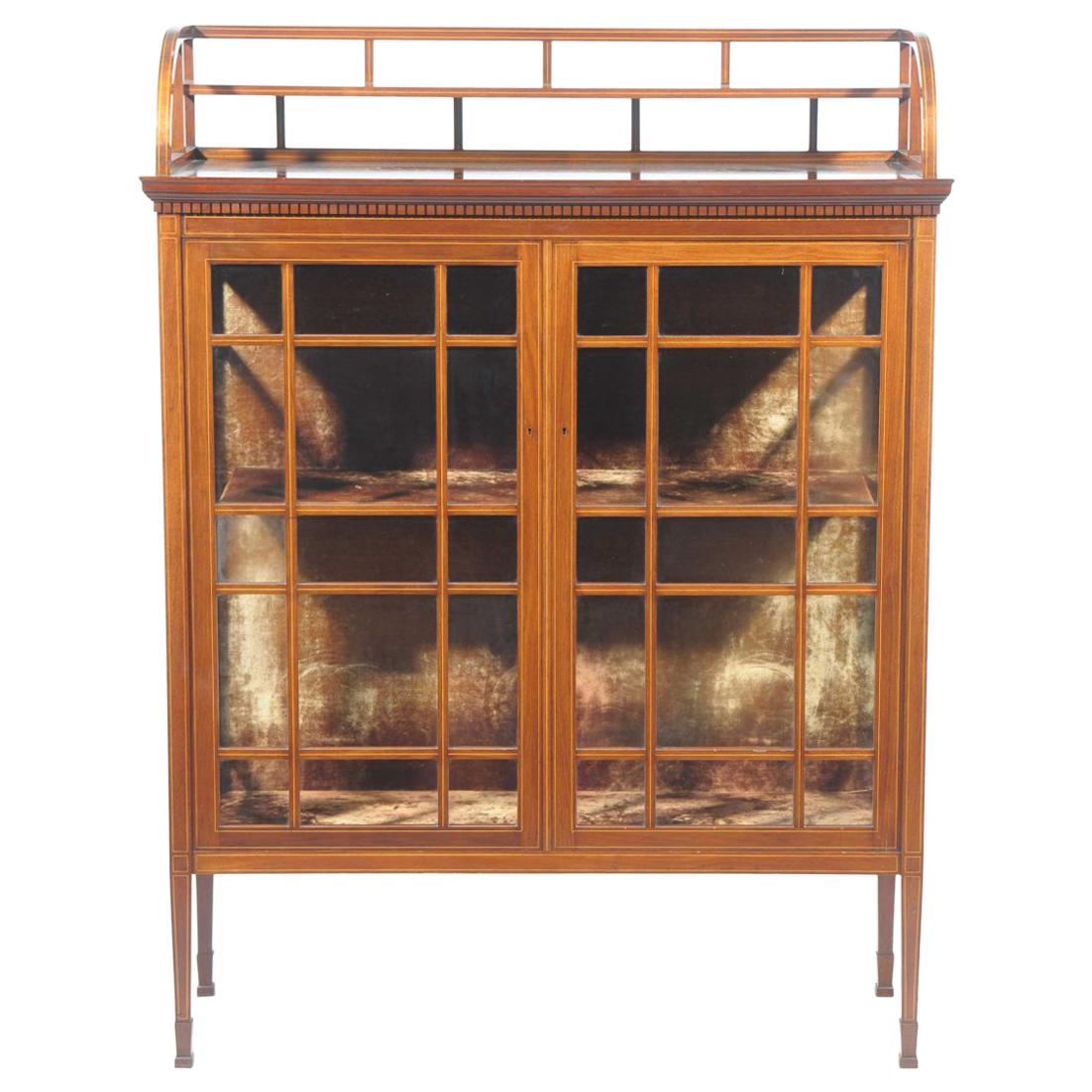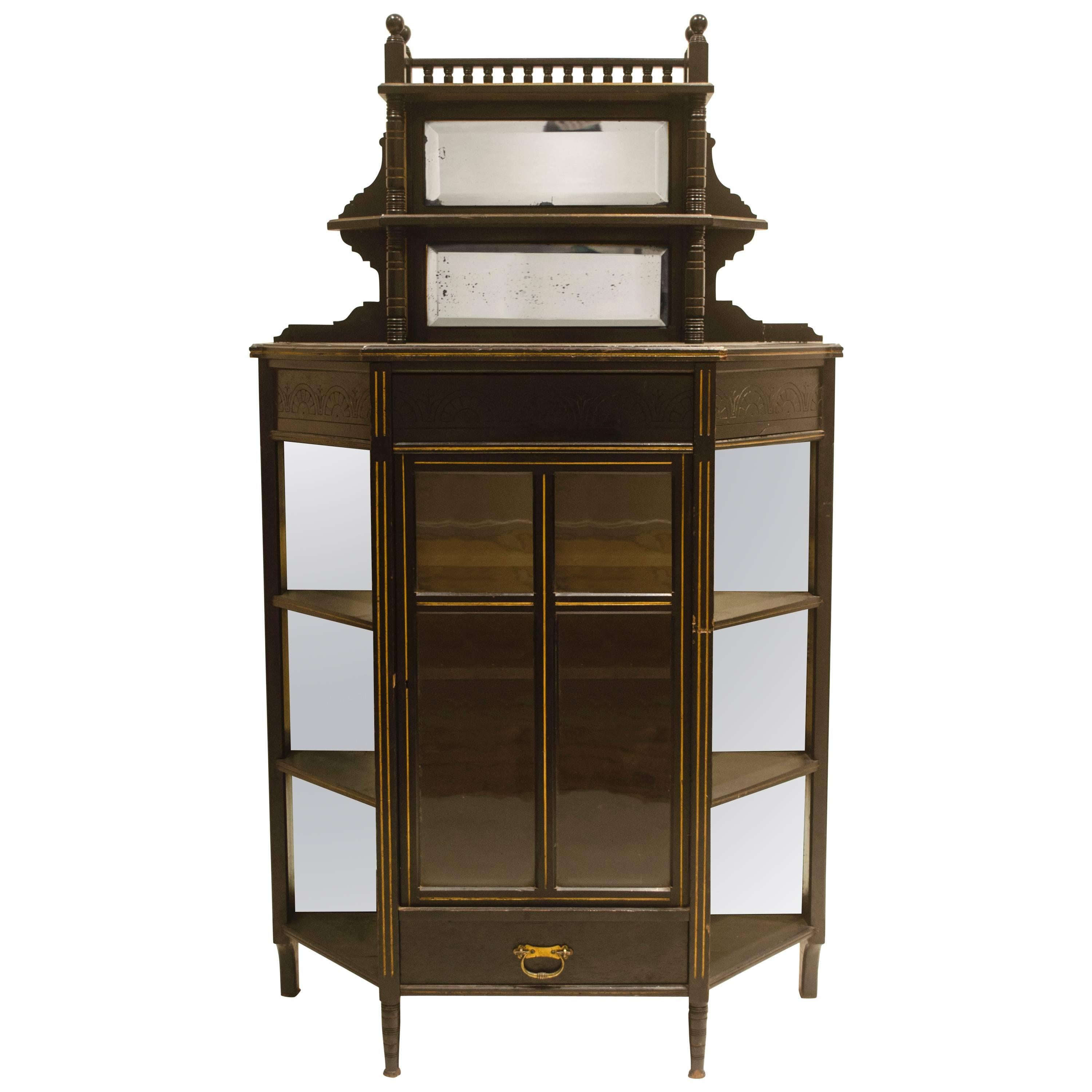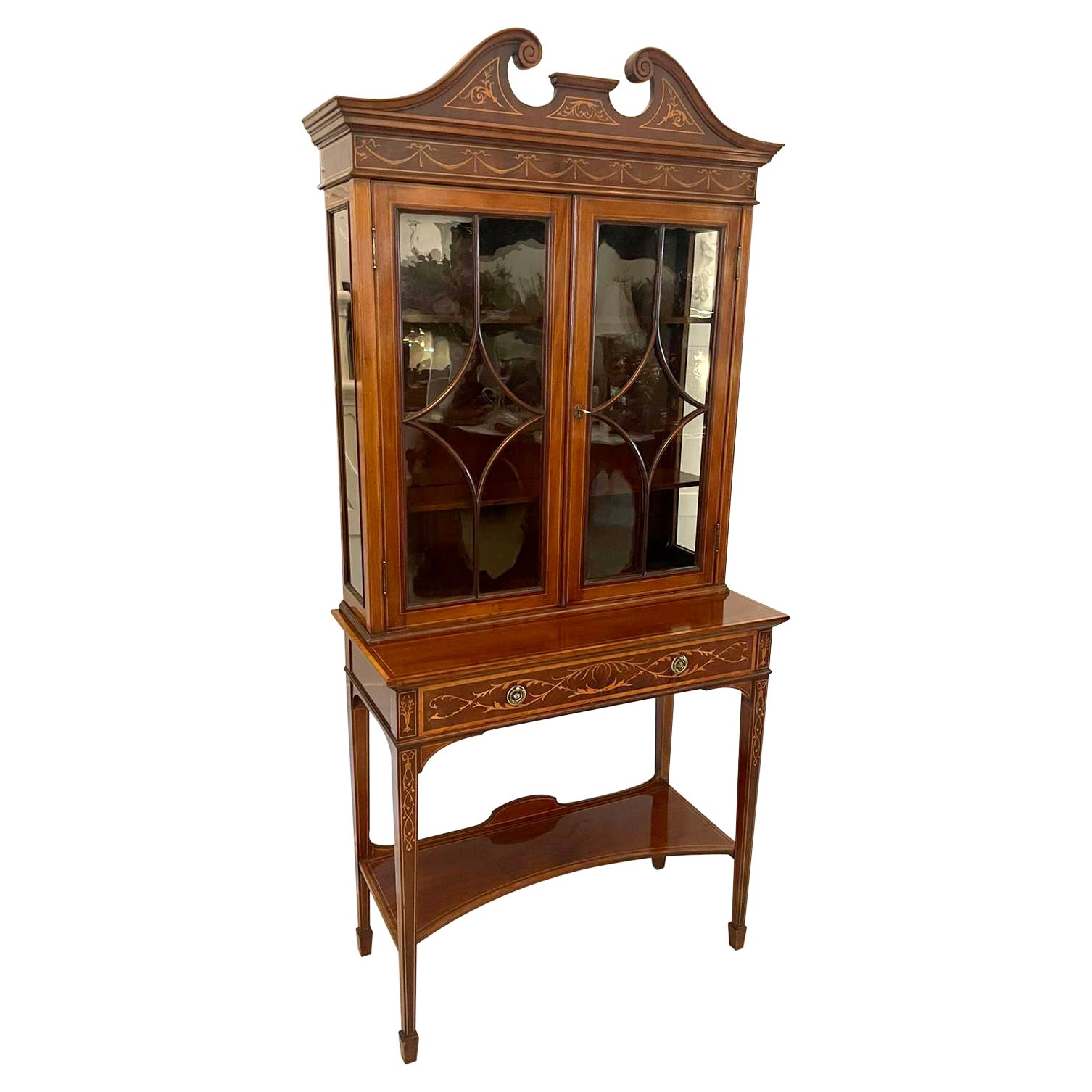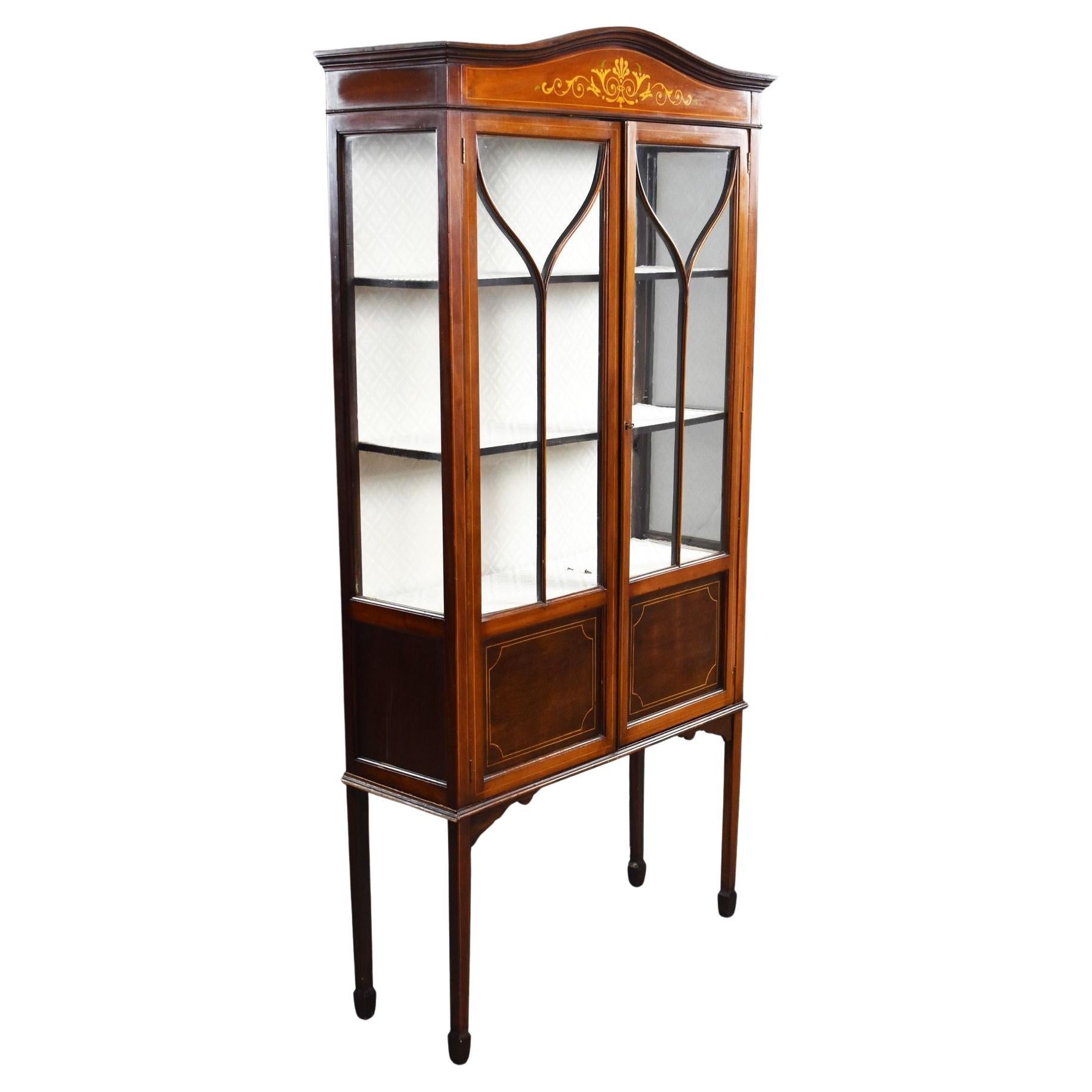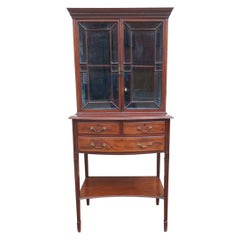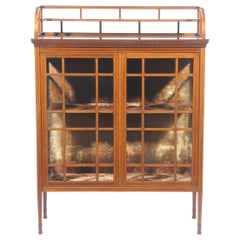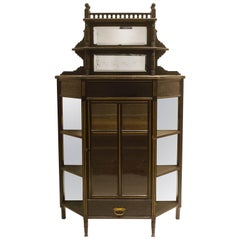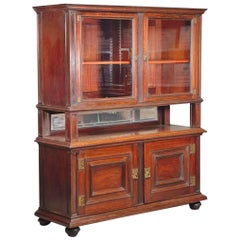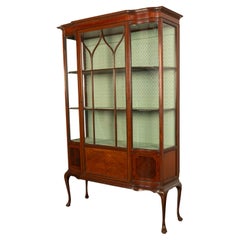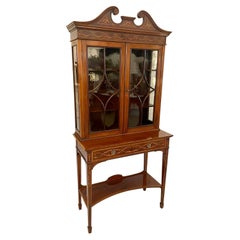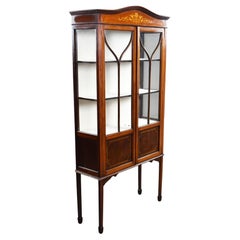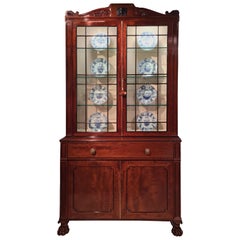Items Similar to 19th C. English Rosewood China Cabinet, E.W. Godwin for Collinson & Lock, London
Want more images or videos?
Request additional images or videos from the seller
1 of 9
19th C. English Rosewood China Cabinet, E.W. Godwin for Collinson & Lock, London
$61,938.72
£45,000
€52,747.26
CA$84,558.12
A$94,067.45
CHF 49,311.34
MX$1,149,481.30
NOK 627,918.35
SEK 591,098.26
DKK 393,738.26
Shipping
Retrieving quote...The 1stDibs Promise:
Authenticity Guarantee,
Money-Back Guarantee,
24-Hour Cancellation
About the Item
Rosewood China Cabinet, circa 1878, designed by Edward William Godwin (1833-1886) for Collinson & Lock, London. From the Collection of Eaton Hall, Cheshire, England. The Eaton Hall cabinet, circa 1878, in rosewood, the scroll-carved broken arched Queen Anne pediment above a dentil and moulded frieze, with a pair of astragal glazed doors flanked by shelves beneath fielded panels, above a central drawer and semi-circular cupboards, the moulded top above a pair of panelled doors with an open panelled section beneath, on shaped splayed feet, japanesque engraved brass handles, hinges and lockplates, stamped 'Collinson and Lock, London 7480', the handles, hinges and lockplates all stamped 'Elsleys, Gt Portland St, London'.
Provenance: Eaton Hall, Cheshire. A previous owner purchased this lot from a sale of the contents at Sweetenhams of Chester, 20th and 21st May 1959, where it states:- '283. Rosewood display cabinet, the upper portion enclosed with astragal glazed doors with side shelves, the lower portion enclosed with two panelled doors. This was the last mention of the Rosewood cabinet before it was sold.
This piece has many features, which firmly show Godwin's hand at work, i.e. Queen Anne broken pediment, (Soros, Susan Weber 'The Secular Furniture of E.W. Godwin', Butterfly cabinet, p. 227; and a Queen Anne cabinet p. 269 and an 'over door', p. 251), the dentil moulding to the top is identical to the Butterfly cabinet, the astragal glazed doors and panelled lower doors identical to a design for a table for Grey Towers (Susan Soros, 'Secular Furniture', p. 157 and similar detail to the doors on two cabinets on pp. 222-223). The semi-circular central side doors and semi-circular open shelves above are identical to a dressing table and a sketch for a dresser (Susan Soros, 'Secular Furniture', p. 211), a design for a mantelpiece (Susan Soros, 'Secular Furniture', p. 248) and a design for a buffet (Susan Soros, 'Secular Furniture', p. 265). The integrated design of solids and voids in many of his cabinet designs and the framed back panels to each individual shelf and framed panels to each side is typical of his work. The splayed front feet are identical to the Four Seasons cabinet (Susan Soros, 'Secular Furniture', p. 217). The elongated handles with japanesque engraved backplates simulate Japanese woven rush work (Susan Soros, 'E.W. Godwin Aesthetic Movement, Architect and Designer', p. 303, fig. 11-10 and Susan Soros, 'Secular Furniture', p. 268) a detail he used in many combinations. 'Sheraton and Queen Anne in Japan at Eaton Hall' only Godwin could have designed this exceptional work of art. Possibly part of a larger commission, the Eaton Hall archivist also found a Collinson and Lock billiard table in the inventory at Eaton Hall.
Godwin is known to have designed billiard tables for Collinson and Lock, a design appears in his sketchbook on the 6th of October 1873, carved in the Jacobean style with circular decorations of white storks in relief interspersed with square panels.
A corresponding entry on the 7th of October 1873 it shows that he designed it for the McLaren house, a large commission that Godwin did at Adison Rd, Kensington. The third Marquis of Westminster, who later became the 2nd Duke of Westminster, commissioned Sir Alfred Waterhouse to substantially remodel and rebuild Eaton Hall. The work began in 1869 and reached its completion in 1883. The large drawing room can be seen in a photograph taken, circa 1887, pl. 199 in Cooper, Jeremy. Victorian and Edwardian Furniture and Interiors, in which Cooper mentions that the Duke had spent 600,000 pounds on the decoration alone and that Heaton, Butler and Bayne carried out the work.
In 1885, an inventory of the contents of Eaton Hall was carried out, and it is precisely at this point in time that the cabinet receives its first mention. Having occupied a place in the Ormand Sitting Room, 72 on the ground floor of the North Wing of the Waterhouse Hall, the cabinet was described as, 'A Rosewood china cabinet with cupboards beneath and glass fronts at the top, 50ins'. The cabinet is then mentioned again in a 1917 inventory in the Angel Bedroom.
The cabinet made its next appearance in 1931 in the 'Declaration of Trusts', which was a valuation of the contents of Eaton Hall, appearing as T86/27 in the Stewards Offices with a similar description, and then finally in the 1959 sale catalogue mentioned above.
Sotheby's and various other local auctioneers held many sales of the various contents of Eaton Hall from 1955 through to 1961 until the Hall was demolished in 1961.
This description was compiled with the generous help and assistance of the Grosvenor Estate's Archive Department, Eaton Hall, Cheshire.
Collinson and Lock of London 'Art Furnishers', founded with the partnership of F.G. Collinson and G.J. Lock, former employees of Jackson and Graham. Designers employed by the firm included T.E. Collcutt, the architect of their premises; E.W. Godwin, who was paid a retainer to produce exclusive designs for the company from 1872 to 1874, H.W. Batley and Stephen Webb. They made furniture for the new Law Courts to designs by G.E. Street, along with Gillows and Holland and Sons, and began the decoration of the Savoy Theatre in 1881. Jackson and Graham were taken over in 1885, at the time when the firm had moved to Oxford Street and begun to focus on expensive commissions for grandiose London houses. The firm was taken over by Gillows in 1897.
The firm of Collinson and Lock was established in London in the third quarter of the 19th century and quickly achieved both commercial success and a leading position in the field of design. In 1871 the firm issued an impressive illustrated catalogue of 'Artistic furniture', with plates drawn by J. Moyar Smith, assistant to Christopher Dresser, and in 1873 was trading from extensive newly built premises in St Bride Street. The firm continued to produce the finest quality items of furniture and soon began to experiment with new materials and designs, becoming especially renowned for their distinctive combinations of rosewood and ivory and their intricate Italianate arabesques, traditional figures and scrolling foliage. That form of decoration clearly points toward the involvement of Stephen Webb, who became Collinson and Lock's chief designer who was later appointed Professor of Sculpture at the Royal College of Art.
E.W.Godwin was Collinson and Lock's most important designer and the leading designer in the Japanese style of the period.
The cabinet breaks down into four pieces for ease of moving, the cornice is one, the centre-upper glazed display with drawer is two, the lower cabinet doors and its lower opening is three, and the plinth with feet is four. Assembled it weighs around 160kg or 25 stone. Separated it is an easy job for two people to move it.
- Creator:Collinson & Lock (Maker)
- Attributed to:Edward William Godwin (Designer)
- Dimensions:Height: 89 in (226.06 cm)Width: 50 in (127 cm)Depth: 16 in (40.64 cm)
- Style:Anglo-Japanese (Of the Period)
- Materials and Techniques:
- Place of Origin:
- Period:
- Date of Manufacture:1878
- Condition:Wear consistent with age and use. The cabinet is in wonderful original condition. The Rosewood is still rich and vibrant with no fading, retaining its original finish which is quite extraordinary. The quality of manufacture is of the highest order that a maker could achieve.
- Seller Location:London, GB
- Reference Number:Seller: NPV0007131stDibs: LU224335803743
About the Seller
5.0
Platinum Seller
Premium sellers with a 4.7+ rating and 24-hour response times
Established in 1989
1stDibs seller since 2016
291 sales on 1stDibs
Typical response time: <1 hour
- ShippingRetrieving quote...Shipping from: London, United Kingdom
- Return Policy
Authenticity Guarantee
In the unlikely event there’s an issue with an item’s authenticity, contact us within 1 year for a full refund. DetailsMoney-Back Guarantee
If your item is not as described, is damaged in transit, or does not arrive, contact us within 7 days for a full refund. Details24-Hour Cancellation
You have a 24-hour grace period in which to reconsider your purchase, with no questions asked.Vetted Professional Sellers
Our world-class sellers must adhere to strict standards for service and quality, maintaining the integrity of our listings.Price-Match Guarantee
If you find that a seller listed the same item for a lower price elsewhere, we’ll match it.Trusted Global Delivery
Our best-in-class carrier network provides specialized shipping options worldwide, including custom delivery.More From This Seller
View AllCollinson & Lock. Aesthetic Movement Anglo-Japanese Glazed Walnut Side Cabinet
By Collinson & Lock
Located in London, GB
Collinson & Lock.
An outstanding quality Aesthetic Movement Anglo-Japanese walnut side cabinet with dentil moulding to the cornice and astr...
Category
Antique Late 19th Century English Aesthetic Movement Cabinets
Materials
Walnut
E W Godwin, Collinson & Lock, an Anglo Japanese Mahogany and Satinwood Cabinet
By Collinson & Lock, Edward William Godwin
Located in London, GB
Edward William Godwin. Made by Collinson & Lock.
A fine quality Anglo Japanese mahogany and astragal glazed cabinet with satinwood line inlay.
...
Category
Antique 1870s English Anglo-Japanese Cabinets
Materials
Mahogany, Satinwood
E W Godwin, William Watt, an Important Anglo-Japanese Ebonised Display Cabinet
By William Watt, Edward William Godwin
Located in London, GB
Edward William Godwin made by William Watt, with applied enamel label.
An Important Anglo-Japanese ebonised display cabinet with an upper and...
Category
Antique 1870s English Anglo-Japanese Cabinets
Materials
Walnut
Anglo-Japanese Rosewood Sideboard, Attributed to E W Godwin
By Edward William Godwin
Located in London, GB
Edward William Godwin (firmly attributed) for Collinson and Lock, a superior quality Anglo-Japanese rosewood sideboard almost certainly designed by Edward William Godwin. Godwin's st...
Category
Antique Late 19th Century Anglo-Japanese Sideboards
Materials
Rosewood
E W Godwin An Important Anglo-Japanese Bookcase Painted by Henry Stacy Marks
By Edward William Godwin
Located in London, GB
Edward William Godwin (1833-1886) for William Watt, a rare and important Anglo-Japanese walnut bookcase, circa 1871. With brass handles and shield style escutcheon, the lower cupboard with two sliding doors inset with painted panels attributed to Henry Stacy Marks...
Category
Antique Late 19th Century British Anglo-Japanese Bookcases
Materials
Walnut, Paint
Arts and Crafts Mahogany Display Cabinet designed by G M Ellwood
By George Montague Ellwood
Located in London, GB
George Montague Ellwood (1875-1955) for J.S. Henry (attributed,) a mahogany and inlaid glazed display cabinet, stamped '301' over '4'.
Category
Early 20th Century Arts and Crafts Cabinets
Materials
Mahogany
You May Also Like
Antique 19th Century Inlaid Mahogany Regency Revival Display China Hutch 1890
Located in Portland, OR
A fine antique late 19th century Regency Revival inlaid mahogany china hutch cabinet in excellent condition, circa 1890.
The cabinet of serpentine shape including the glass panels, t...
Category
Antique Late 19th Century English Regency Revival Vitrines
Materials
Mahogany, Satin, Glass, Ebony, Satinwood
Quality Antique Mahogany Inlaid Display Cabinet by Edwards & Roberts, London
Located in Suffolk, GB
Fine quality antique Victorian mahogany inlaid display cabinet by Edwards and Roberts having a quality mahogany swan neck pediment with satinwood inlay above an inlaid frieze with sw...
Category
Antique 1880s English Victorian Cabinets
Materials
Other
$3,771 Sale Price
20% Off
Edwardian Mahogany Hand Painted China Cabinet
Located in Chelmsford, Essex
Elegant Edwardian Mahogany Inlaid Display Cabinet
Item Code: 1326A
A refined and elegant Edwardian mahogany display cabinet of slender proportions. Dating from circa 1910, this cabin...
Category
Early 20th Century English Vitrines
Materials
Mahogany
Regency Period Mahogany Secretaire Bookcase, Designs by Thomas Hope
By Thomas Hope
Located in London, GB
A fine quality early 19th century Regency period fiddle-back mahogany secretaire bookcase, in the manner of Thomas Hope, having scrolled and anthemion carved cornice with central applied bronze plaque depicting classical heads. The bookcase, with ebony framed panels throughout, having geometric glazing bars above secretaire drawer and panelled cupboard doors below, supported on bold lion's paw feet.
The tragedy and comedy masks, represented on the top of the bookcase, are possibly designed by Thomas Hope. Hope represented a series of comic and tragic masks in his book “Household Furniture...
Category
Antique Early 19th Century English Regency Bookcases
Materials
Mahogany
Outstanding Inlaid Edwardian China Cabinet or Vitrine Attr. Edwards and Roberts
By Edwards & Roberts
Located in Swedesboro, NJ
For customers that require professional insured delivery we are proud to have teamed up with a nationwide professional delivery company that will assist with coordinating your delive...
Category
Antique 1890s English Edwardian Vitrines
Materials
Blown Glass, Walnut
$3,036 Sale Price
20% Off
English Mahogany Showcase Cabinet, 19th Century
Located in Madrid, ES
English showcase. Mahogany wood, XIX century.
Showcase with shelves and two doors with glass and geometric decoration topped by a split pediment wi...
Category
Antique 19th Century English Neoclassical Cabinets
Materials
Metal
More Ways To Browse
Brass Lock
Entry Cabinet
Lock Of London
Semi China
English China Plates
Glass Table Display Cabinets
William Rushing
Glass Top China Cabinets
Antique English Cabinet Plate Plate
Chinese Plinth
Chinese Door Handles
Japanese Display Case
Chinese Scroll Cabinets
Chinese Cabinet With Lock
Dutch Display Cabinets
Display Cabinet Japanese
The Four Seasons 19th Century
Chinese Brass Lock
